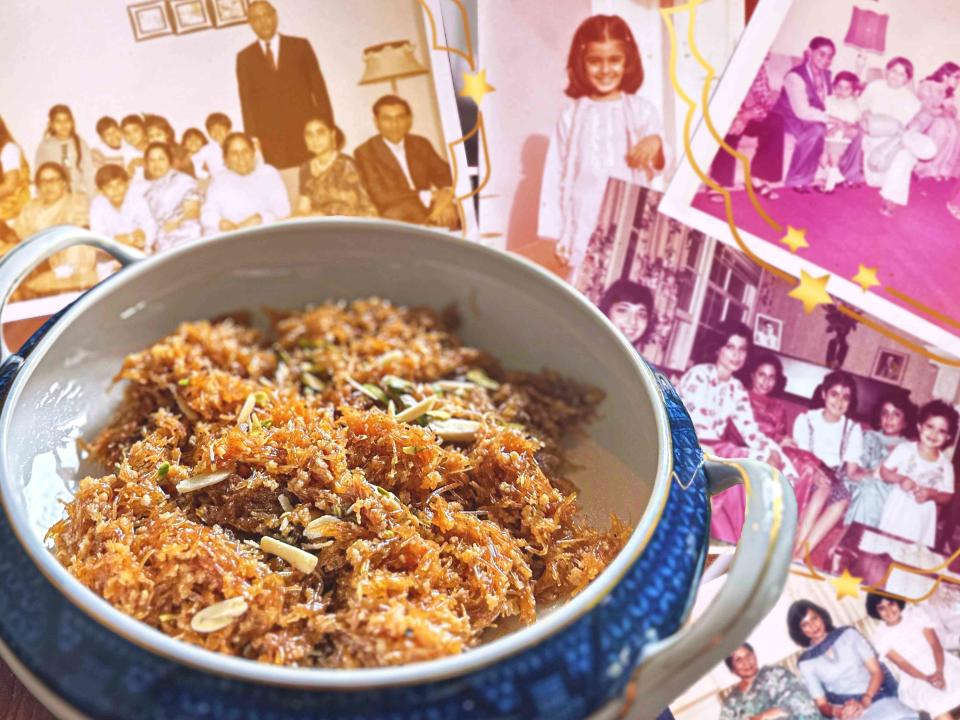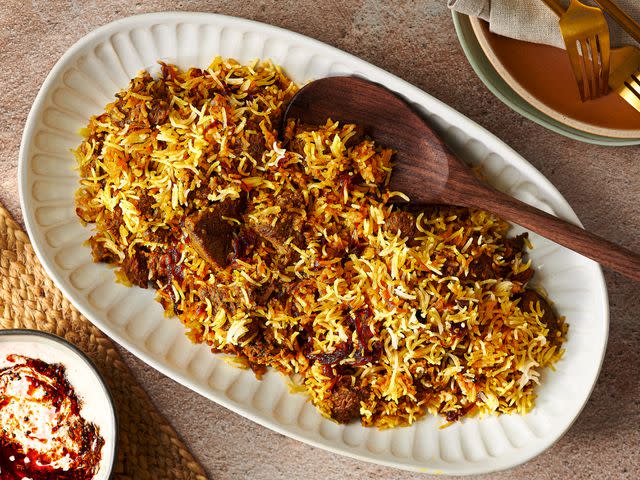Reconnecting With Eid Traditions in a New Home
When I relocated from Pakistan to London, I knew Eid would be different and that was OK—until I realized the things that I missed, including the festive foods.

Courtesy of Sumayya Usmani; Getty Images
The low ceiling of my London flat was filled with festive smoke. Saffron, cardamom, and cloves slowly infused in sugar syrup while I cooked roasted vermicelli with ghee in another pan for the seviyan dessert. I hadn’t cooked like this in years, and my small London flat’s smoke alarm was close to activation.
It was my first Eid away from my family, and partly, it felt liberating. Growing up in Pakistan, I had grown tired of familial expectations, especially around the Eid holidays. I moved to London when I was thirty-three, before later moving to Scotland, and I was looking for a chance at a new life. I was relieved to get away from small talk over samosas and chai with relatives and chewing politely behind a saccharine smile. I accepted that Eid would be lonely living in the U.K. and that suited me just fine.
There were some moments I knew I’d miss, like waking up to the warm scents of cardamom and roasted vermicelli. Each Eid morning, Mummy made my Dadi (paternal grandmother) her Qawami seviyan (pictured above), which included sixteen parts sugar to one part fine roasted vermicelli, along with cloves, saffron, and cardamom. This was an indulgent Eid breakfast in our home that I looked forward to, but that delight was often dulled by my mother’s narration of the day's visits to family members. It was the judgment from relatives that I hated most—those sideways glances and hushed tones about my divorce, or the eyebrow raises at my tattooed arms peeping through my kurta sleeve.
The month of Ramadan itself felt unceremonious in England. I missed the shorter working days Ramadan brought with it in Pakistan. On the way home from work when I was in Pakistan, we’d pick up fried snacks to break the fast with at iftar. Every street corner would be lined with stalls selling chickpea battered deep-fried pakoras, and saffron syrup-dipped donuts called jalebis just before sunset. Around the end of Ramadan, my mother would buy boxes full of groceries to give to families in need for Eid. Thinking of shopping with my cousins on Chand Raat (the night before Eid), and the organized chaos of the bazaars where we’d stain our hands with henna patterns and buy coloured glass bangles to match our new Eid outfits filled me with nostalgia.
In England, there was none of that. I’d convinced myself to try and conform with my new surroundings and didn’t tell anyone I was fasting. I had to work as usual through Ramadan and my hunger would peak at midday when my colleagues consumed sandwiches and salads at their desks in our open-plan office. One day at lunchtime, I decided to join them in the office cafeteria so I could get to know people. Alice, my boss, asked why I wasn’t eating, and I told her about Ramadan and Eid. I shared stories of my mother’s cooking and the all-encompassing scents of saffron and cardamom that always wafted through our kitchen, the itchy Eid clothes I’d wear, the clinking glass bangles that graced my arms, and the henna on my palms. I also told her about the aunties and uncles with their judgment and gossip. Before I knew it, my stories of warmer places and delicious food led Alice to invite herself over alongside my friends for Eid.

Serious Eats / Qi Ai
Pictured: Lamb Biryani With Saffron, Yogurt, and Caramelized OnionsFor years, Mummy had picked on me for not learning Eid recipes, and now I wished so much that I’d paid attention. With the help of long phone calls with my mother, I found myself immersed in curating the perfect Eid menu to impress my boss. Mummy gave me vague lists of ingredients, and I attempted to convert her confusing instructions into actual measurements and methods. Finally, I decided to make Sindhi biryani, a layered rice dish with pomegranate and dried plums with mutton or beef, and haleem, a lentil and meat porridge with garam masala, as well as fresh homemade naans; for dessert, I opted for my Dadi’s seviyan and rasmalai, sweet cottage cheese dumplings in milk.
My local South Asian store had most ingredients for the biryani like aloo bukhara (dried plum) and anardana (dried pomegranate), as well as the roasted fine vermicelli for seviyan. Mutton for the biryani, however, proved more problematic, so I resorted to using beef. I decided to attempt my mother’s dahi baras as well—these comforting chickpea flour dumplings with cool yogurt, tamarind, and mint chutneys were always on the Eid table. As I walked through the aisles of the store, the familiar spice labels and the shelves filled with Pakistani rice and atta flour filled me with an ache for home. I longed for my mother’s cooking; I even missed her voice that berated me to learn to cook.
As I prepared for the Eid lunch that day, heating whole spices in ghee, something about the cocktail of korma spices for my biryani evoked my lost anticipation for Eid. I didn’t feel alone in the kitchen; it was as if both my grandmother’s ghosts were at my side, telling me when to stir or add ingredients. The voices of the women from my family who prepared this same meal in the past felt present there that day, even though this tiny London loft kitchen was so far removed from my family kitchen in Karachi. There was something about the act of cooking Eid lunch that created a sense of home and a rekindling of happier memories.
I was transported to a time when Eid meant more than just the judging aunties and boring conversations. I remembered what my Nani (maternal grandmother) had always called “vintage Eid.” Each year, her elder brother, Iqbal, hosted a large Eid dinner at his beautiful home in Karachi. Uncle Iqbal had been in the foreign service and was posted in Washington, DC for many years; when he returned, he'd built a home reminiscent of American homes with mantel places and large windows—it was very unlike the homes in Pakistan, so I found it fascinating. Best of all, he brought back American sweets to give to the children on Eid: Twinkies, M&M’s, and Fruit Roll-Ups, all of which were impossible to find in Pakistan.
I also looked forward to the envelopes of Eidee money we’d receive from all the relatives, a tradition on Eid for young children. All the female family members, including my grandmothers and my mother, would sit in the vintage-style drawing room with floral wallpaper, rosewood carved furniture, and a large piano that was always left unplayed, and the men would be in the cigar room. The faint smell of spices and the charcoal from the barbeque in the back open-air kitchen would mingle with the honeyed cigar smoke. The uncles in their three-piece suits would greet each other with formal hugs and the aunties in their shiny, mismatched shalwar kameez outfits would kiss me, leaving their lipstick stains on my cheek.
I’d bear it all for the sweets, the money, and the lavish Eid lunch that Uncle Iqbal’s cook created; this was what everyone came together for after all. Lunch would be served in the airy dining room that had a slight musty old wood smell. The heavy mahogany dining table in the middle of the room was packed with so many dishes that you could barely see its surface. The beige lace curtains in the French windows always looked dusty and the silver candelabra lay on the side credenza was blackened with diskeep. I could hear a faint string quartet playing, but I never spotted speakers anywhere.
Everyone would rush to the table, crowding around the dishes like moths. There were freshly made shish kebabs and naans from the tandoor, haleem, raita, and nihari, a slow-cooked meat stew flavored with spices, along with condiments like finely slivered ginger, coriander, mint, and browned onions; a platter of mutton biryani served as the centerpiece of the table. Dessert would be served an hour later: rasmalai, seviyan, and pistachio kulfi ice cream. Luckily for me, children would get first dibs at dessert. We’d eat about four helpings and come home in the early afternoon, only to fall into a deep food coma.
As I prepared my Eid meal in London, I felt something shift. I’d spent so long focusing on the negative memories of Eid and blocking out the happier ones—family and the festive chatter that filled the walls of our homes with joy. I forgot the aunties and their remarks and instead, remembered my grandmothers, the candy, kulfi, the packs of Eidee, and all of us together at Uncle Iqbal’s home. Now, I’d brought together new friends in a new home around a meal that represented my traditions. Alice was left in awe of the flavors of Pakistani food.
As I served my grandmother’s seviyan to my coworkers, I sent a photo of it to my mother, who was impressed at how much it looked like hers. It even tasted the same—maybe because I put in just the same amount of love and commitment in cooking as my grandmothers and mother did. I felt proud of this inescapable part of who I was—my culinary culture and my family recipes, something that I could recreate and share wherever I was. That year I reconnected with Eid and celebrated the festival’s true essence of gratitude, tradition, and making memories.
Read the original article on Serious Eats.

